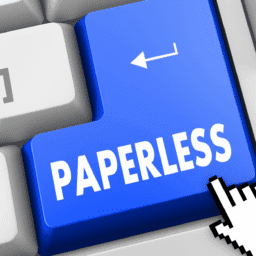There’s no denying that business is moving faster than ever. So, more efficient, streamlined, and eco-friendly processes are needed more than ever. This is particularly true in the realm of human resources, where the onboarding of new employees presents a significant logistical challenge. Enter paperless onboarding – a modern solution that accelerates the hiring process and aligns with contemporary sustainability and efficiency goals. This ultimate guide delves into the ins and outs of paperless onboarding, offering comprehensive insights for businesses looking to make the transition.
Understanding Paperless Onboarding
What Is Paperless Onboarding? Paperless onboarding integrates new employees into an organization using digital tools and systems, eliminating the need for physical paperwork. This method encompasses everything from filling out employment forms and contracts to conducting orientation programs – all in a digital format.
Why the Shift to Paperless? The shift to paperless onboarding is driven by several factors: the increasing need for efficiency in the hiring process, the growing emphasis on data security, and the global push toward sustainability. Moving away from paper-based systems allows companies to enjoy a faster, more secure, and environmentally friendly onboarding experience.
The Benefits of Going Paperless
1. Enhanced Efficiency: Digital forms and automated workflows significantly reduce the time it takes to onboard new employees, making the process more dynamic and less time-consuming.
2. Improved Accuracy and Compliance: Automated data entry and digital record-keeping reduce the likelihood of human error, ensuring greater accuracy in employee records. Additionally, digital systems can be quickly updated to comply with changing legal requirements, enhancing compliance.
3. Cost Reduction: By reducing the reliance on paper, printing, and physical storage, companies can achieve significant cost savings.
4. Positive Environmental Impact: A paperless approach aligns with sustainability goals, reducing the company’s carbon footprint.
5. Enhanced Employee Experience: A smooth, efficient onboarding process contributes to a positive initial experience for new hires, setting a constructive tone for their tenure at the company.
6. Data Security: Digital onboarding platforms often offer enhanced security features, protecting sensitive employee information more effectively than paper-based systems.
Implementing a Paperless Onboarding System
Choosing the Right Platform The foundation of an effective, paperless onboarding process is the right digital platform. Look for solutions that offer user-friendly interfaces, customizable forms, electronic signature capabilities, and seamless integration with existing HR systems.
Training and Support: Ensure your HR team is well-trained on the new digital platform. Provide ongoing support to address any challenges that arise during the transition to a paperless system.
Clear Communication Effective communication with new hires is essential. Clearly explain the paperless onboarding process, highlighting its benefits and offering guidance on navigating the digital platform.
Feedback and Continuous Improvement: Regularly collect feedback from new hires and HR staff to identify areas for improvement. Continuous refinement is key to maintaining an effective, paperless onboarding process.
Best Practices for Paperless Onboarding
1. Customizable Workflows: Tailor the onboarding process to suit your organization’s unique needs and different employee roles.
2. Interactive and Engaging Content: Use multimedia and interactive elements to make the onboarding process more engaging for new hires.
3. Consistent Updates and Maintenance: Regularly update your digital onboarding tools to keep them current and effective.
4. Integration with Other HR Functions: Ensure your paperless onboarding system works with other HR processes, such as payroll and performance management.
5. Accessibility and Mobile Optimization: Make sure your digital onboarding platform is accessible and mobile-friendly to accommodate the needs of all employees.
While the transition to a paperless system offers many benefits, it can also present challenges such as resistance to change, technical issues, or data security concerns. Address these challenges by providing adequate training, ensuring robust technical support, and prioritizing data security in your digital platform choice.





